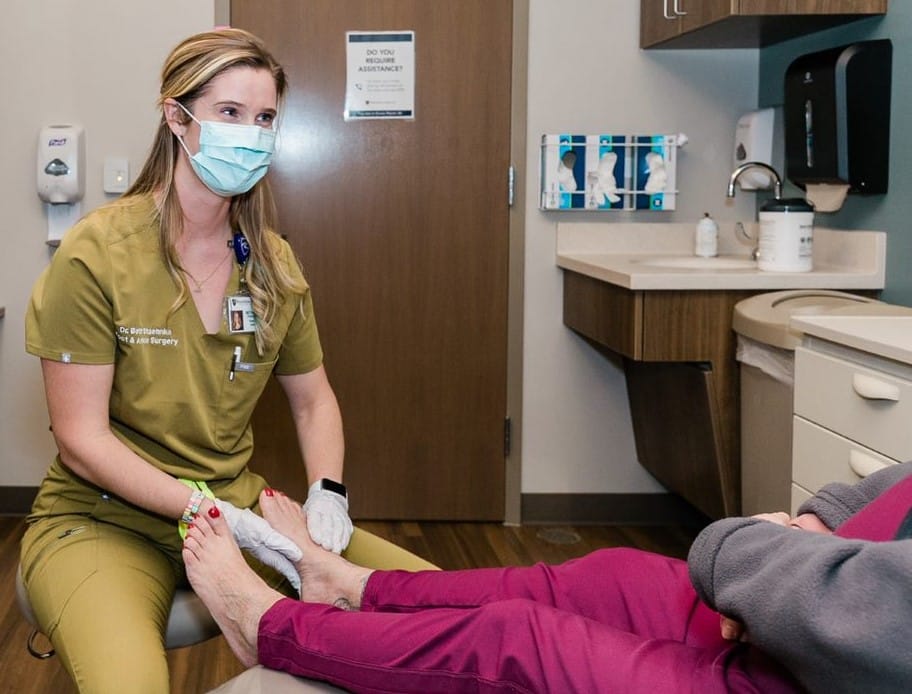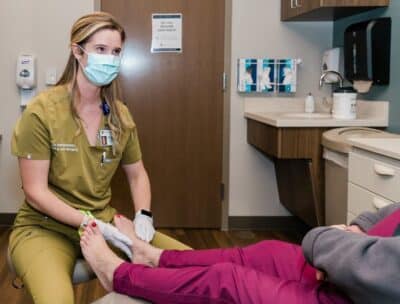November is National Diabetes Month, a time to bring attention to the disease and share ways to improve the lives of those living with it.
This year’s focus is on managing diabetes by building your healthcare team. If you have diabetes, you know it takes a team to manage diabetes. If you do not already have RiverView Health Podiatrist Bethany Staehnke, DPM, on your team, you should. Dr. Staehnke works with patients to address minor issues before they become big problems.
If you have diabetes, it is important to protect your feet before walking out the door. The disease can cause nerve damage and other issues that make you less likely to notice when you have a problem with your feet. Diabetes can also slow down healing. As a result, even a small sore on your foot could turn into a foot ulcer – a wound that does not heal.
Diabetic foot or leg amputation is a primary complication of diabetes. According to the Centers for Disease Control and Prevention, in the United States, every year, about 73,000 lower limb amputations are performed on people with diabetes. More than 85% of these amputations are due to a diabetic foot ulcer.
Dr. Staehnke shares the following tips for keeping your feet healthy:
- Control Your Blood Sugar: Elevated blood sugar (glucose) levels can damage your feet. Healthy habits, like exercising and eating right, can help you maintain good glucose levels. If you use insulin or oral medications, take them as your doctor or nurse tells you.
- Quit Smoking – Smoking increases your risk for foot ulcers by reducing circulation.
- Wash and Check Your Feet Every Day – Use lukewarm water and mild soap to wash your feet. Dry them well, especially between the toes, where trapped moisture may promote infection.
- After washing is a good time to check your feet. Look for blisters, cuts, sores, broken skin, redness, or swelling. Report any concerns to your provider. If you cannot reach your feet, use a mirror or ask a loved one for help.
- Avoid Injury – Protecting your feet from cuts, scrapes, or burns can help you prevent infections. Use these three strategies:
- Do not go barefoot (even indoors).
- Check for pebbles in your shoes before putting them on.
- Avoid heating pads and hot baths, especially if you have lost feeling in your feet.
- Choose the Right Shoes – Choose shoes that fit snugly (not too tight or loose) with room for your toes. Break new shoes in by wearing them for no more than a couple of hours at a time at first. Also, avoid tight socks, which can reduce blood flow to your feet.
- Trim Your Nails Straight Across – If you cut your toenails at the sides or trim them too short, you might nick your skin, paving the way for a possible infection.
- See your provider if you have an ingrown nail, callous, or corn; do not remove yourself.
- Choose Foot-Friendly Exercises – Walking is often a good option. However, if you have foot problems, other activities, like riding a bike or swimming, may be better choices. Ask your provider what is right for you.
- Contact Your Provider at the First Sign of a Foot Problem – Even minor issues may lead to ulcers if left untreated. Any of the following signs is a reason to see your provider right away:
- Poor hair growth or nails that look yellow, thick, or crumbly.
- Changes in the shape, color, or temperature of your feet.
- Tingling, burning, or pain.
- Loss of feeling.
- Dry, cracked skin.
- Blisters, sores, or other injuries.
- Fungus infections (like athlete’s foot) between your toes.
- Pain or cramping in your legs, thighs, or buttocks during physical activity.
Whether diabetic or not, if you have concerns about your feet, make an appointment with Dr. Staehnke by calling 281-9595.





